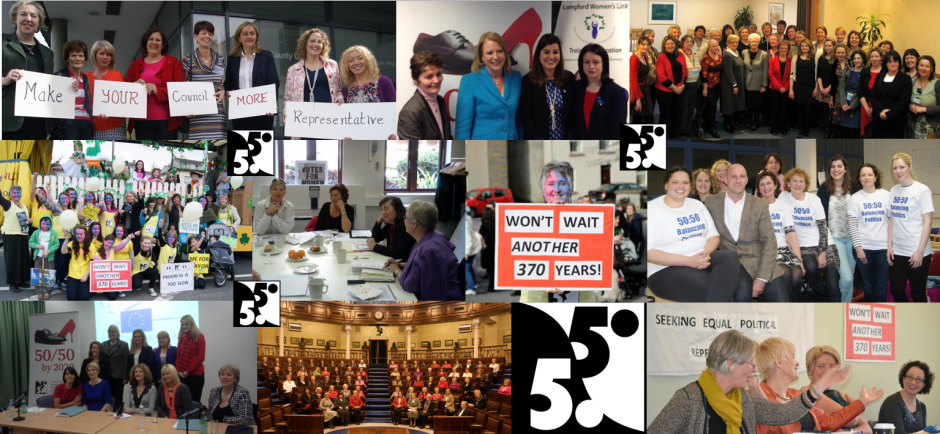- Only 25 of 166 Dáil seats are held by women (15.25%)
- Ireland occupies 79th position of 133 nation-states in IPU rankings
- Ireland is in 22nd place amongst 27 EU member states
- Of 4,744 Dáil seats filled since 1918, only 260 (5.48%) have been occupied by women
- Only 91 women have been elected to Dáil Éireann since foundation of the State
- 181 people served in cabinet in Ireland since 1922, 12 (7%) have been women
- With 15.25% female representation in lower house of parliament, Ireland is behind both world average 19.5 % & European Union average 24%
- Seanad – 18 of 60 seats (30%) are held by women – only 86 women have served in Seanad
- Women account for 17% of members of local authorities & just 12% of members of regional authorities
- 86 women out of 564 candidates contested 2011 General Election – lowest number of women candidates to contest a General Election since 1989
- In 21 of 43 constituencies – there are no women TDs
- National Women’s Council of Ireland estimated that, at present rate, it will take 370 years before gender parity in political representation is achieved in Ireland
Mary Robinson:
“A society that is without the voice and vision of a woman is not less feminine. It is less human.”
______________________________________
Barriers to women’s participation in Irish Politics
There are 5 ‘C’s :
- Care (childcare & other)
- Cash
- Candidate selection
- Culture
- Confidence
No – say White (2006); Buckley, Collins & Reidy (2007); Marsh & McElroy (2010); Buckley & McGing (2011)
- NWCI survey of 2009 Local Elections – some female candidates subjected to sexist comments
- O’Kelly (2000) found evidence of bias against women candidates in Irish political parties
- Act as a process of change & facilitator of women’s political inclusion
- Compensate for many gendered barriers to accessing political office
Implementation - Constitutional approach (e.g. France, Rwanda)
- Legislative approach (e.g. Belgium, Spain, Poland, Argentina)
- Voluntary approach (e.g. Scandinavian countries; Germany)
- Results /Outcome (Reserve Seats)
- Nomination (Candidate Selection) – this is proposed in Ireland
- Legacy of
(i) historical exclusion of women from political citizenship (ie suffrage)
(ii) bias towards traditional gender roles have resulted in women’s under-representation worldwide
_______________________________
Quotas – things to consider
Do ‘gender quotas’ work?
- 17 of the top 20 nations, in terms of women’s political representation, have gender quotas
- Incremental progress rather than fast-track changes
How is the quota enforced & monitored? - Sanctions for non-compliance must be effective
Are gender quotas democratic/fair?
Liberals say ‘no’ but others say they are compensatory & promote democracy
What about the ‘merit’ debate?
- Naïve to assume all politicians make it on merit alone
- What of family dynasties; the ‘GAA’ or ‘celebrity’ candidate; differing access to funding
- Proposes that half of state funding of political parties be contingent on at least 30% of candidates being women & at least 30% being men
- Quota to rise to 40% after 7 years
- Only applies at General Elections.; why not Local Government?
- Why wait 7 years to raise quota; why not sooner?
- Why 30% initially; why not higher?
- Why a legislative quota now?
- Lack of progress; static development; Government policy
- But have other strategies been used? Yes, but these have not been effective (see Claire McGing presentation)
- Lack of party leadership & commitment
- Where will the political parties ‘find’ women candidates?
- Draw from their membership – Women party members DO exist!!
Fine Gael: 42%; Labour: 37%; FiannaFáil: 34% & Sinn Féin: 24% - Head-hunt
- Change selection processes – have all- women shortlists at nomination stage ?
We must expand the level of female representation from civil to political sphere!!
_____________________________
- Quotas provide an opportunity structure to facilitate women’s electoral candidacy (access to the ballot paper)
- Quotas provide voters with greater electoral choice ((i) option to choose between men & women & (ii) between women of different parties
- Ireland’s record in relation to women’s political representation is a travesty of democracy
If not quotas, what is the alternative? If not now – when?
